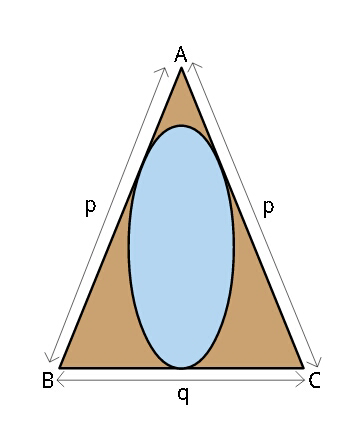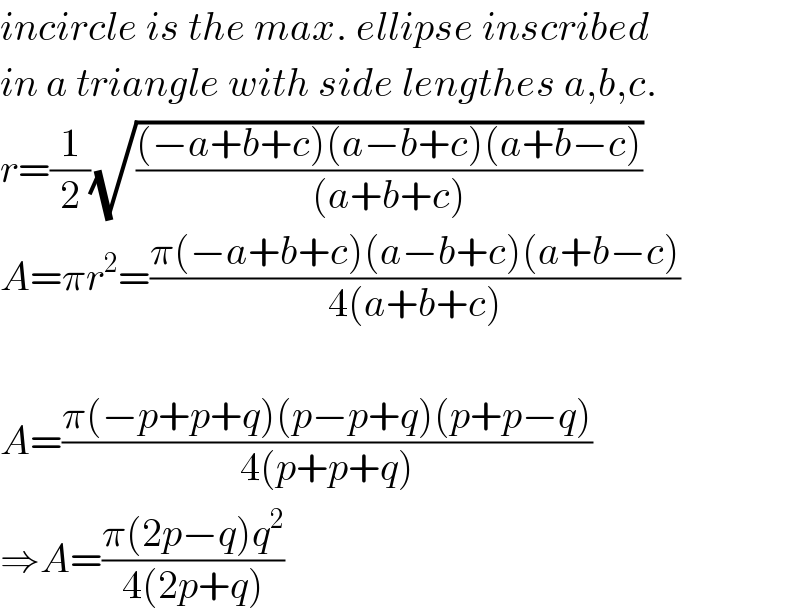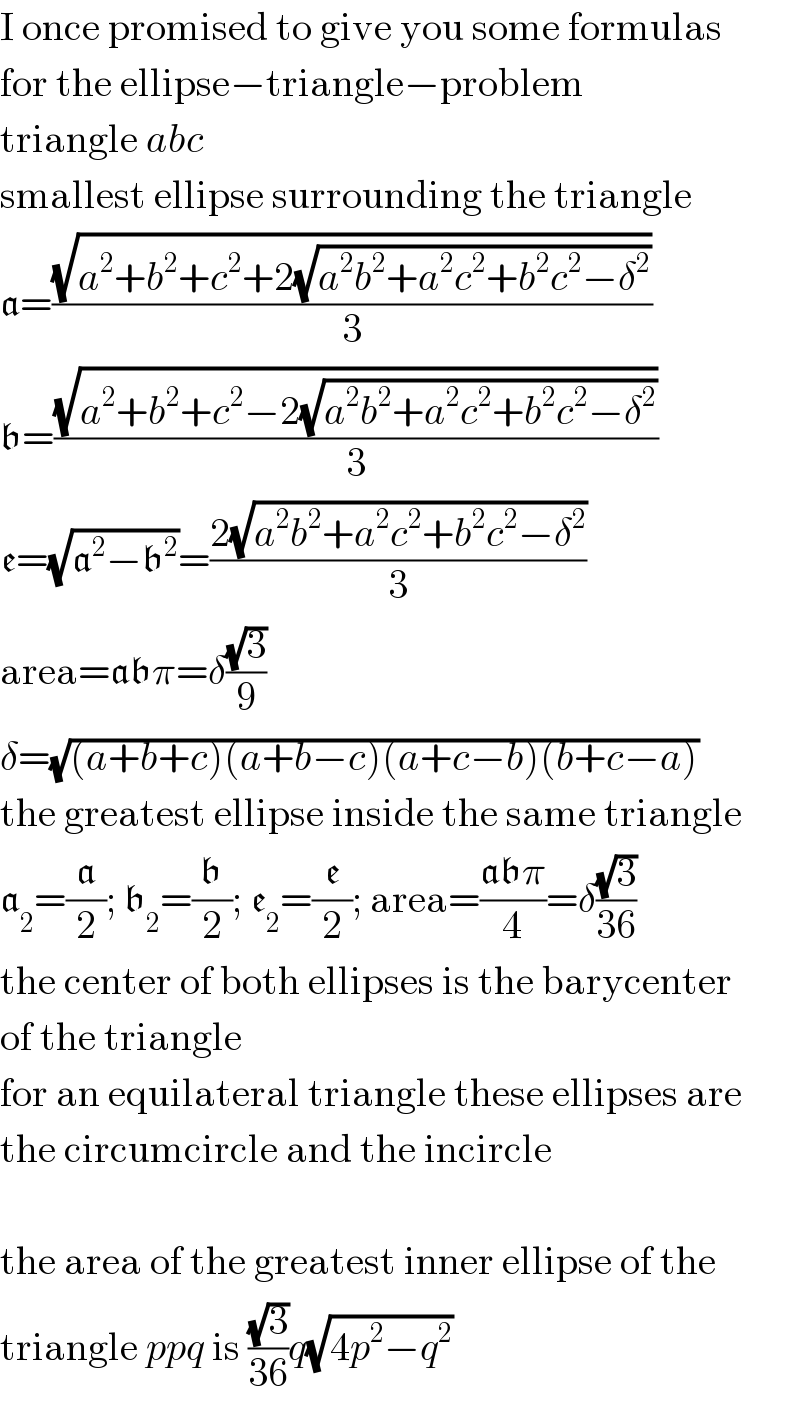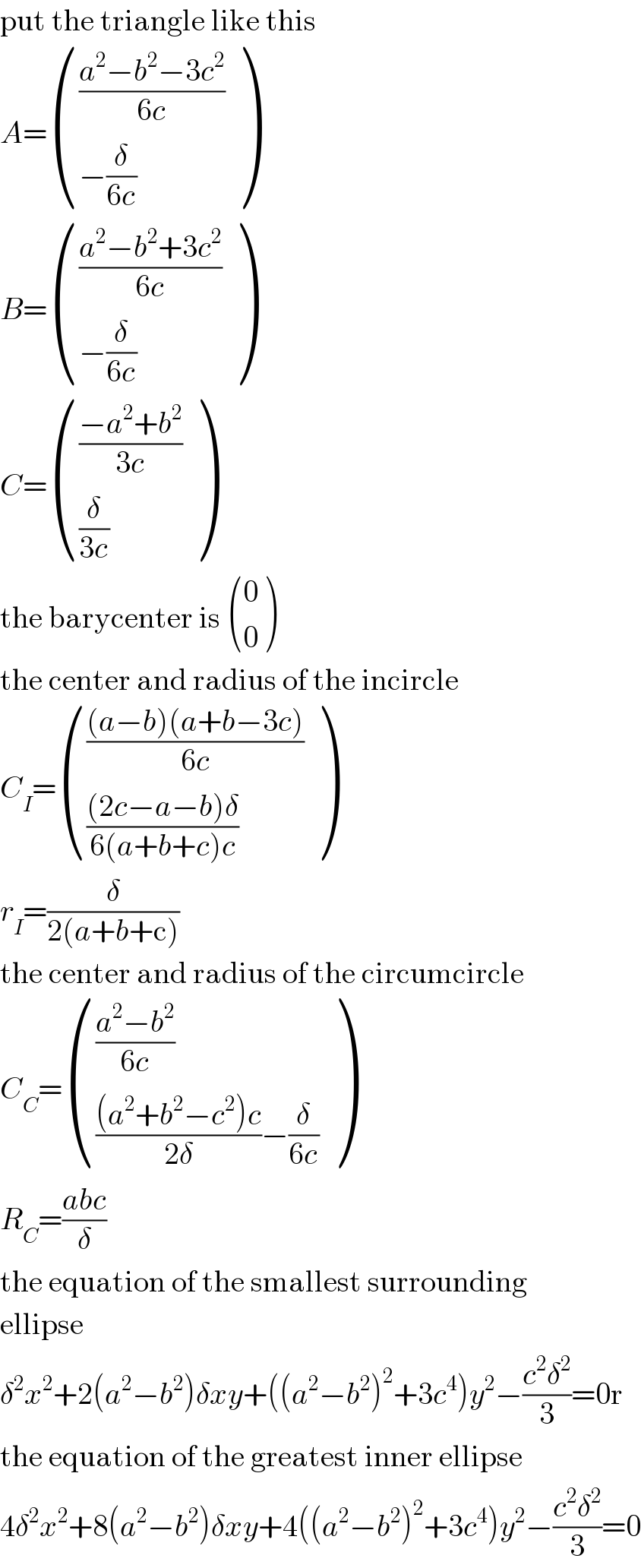Question Number 37447 by ajfour last updated on 13/Jun/18

Commented by ajfour last updated on 13/Jun/18

$${Find}\:{the}\:{maximum}\:{elliptic}\:{area} \\ $$$$\left({in}\:{the}\:{shown}\:{orientation}\right)\: \\ $$$${cicumscribed}\:{by}\:{the}\:{isosceles} \\ $$$${triangle}. \\ $$
Commented by MrW3 last updated on 13/Jun/18

$${incircle}\:{is}\:{the}\:{max}.\:{ellipse}\:{inscribed} \\ $$$${in}\:{a}\:{triangle}\:{with}\:{side}\:{lengthes}\:{a},{b},{c}. \\ $$$${r}=\frac{\mathrm{1}}{\mathrm{2}}\sqrt{\frac{\left(−{a}+{b}+{c}\right)\left({a}−{b}+{c}\right)\left({a}+{b}−{c}\right)}{\left({a}+{b}+{c}\right)}} \\ $$$${A}=\pi{r}^{\mathrm{2}} =\frac{\pi\left(−{a}+{b}+{c}\right)\left({a}−{b}+{c}\right)\left({a}+{b}−{c}\right)}{\mathrm{4}\left({a}+{b}+{c}\right)} \\ $$$$ \\ $$$${A}=\frac{\pi\left(−{p}+{p}+{q}\right)\left({p}−{p}+{q}\right)\left({p}+{p}−{q}\right)}{\mathrm{4}\left({p}+{p}+{q}\right)} \\ $$$$\Rightarrow{A}=\frac{\pi\left(\mathrm{2}{p}−{q}\right){q}^{\mathrm{2}} }{\mathrm{4}\left(\mathrm{2}{p}+{q}\right)} \\ $$
Commented by ajfour last updated on 13/Jun/18

$${Thank}\:{you}\:{Sir},\:{but}\:{my}\:{solution} \\ $$$${fetches}\:{some}\:{other}\:{conclusion}. \\ $$
Commented by MJS last updated on 13/Jun/18

$$\mathrm{incircle}\:\mathrm{is}\:\mathrm{not}\:\mathrm{the}\:\mathrm{greatest}\:\mathrm{ellipse}\:\mathrm{inside}\:\mathrm{a} \\ $$$$\mathrm{triangle}\:\mathrm{and}\:\mathrm{circumcircle}\:\mathrm{is}\:\mathrm{not}\:\mathrm{the}\:\mathrm{smallest} \\ $$$$\mathrm{ellipse}\:\mathrm{surrounding}\:\mathrm{it}.\:\mathrm{see}\:\mathrm{my}\:\mathrm{answer}\:\mathrm{below} \\ $$
Commented by MrW3 last updated on 13/Jun/18

$${Thanks}\:{for}\:{the}\:{information}! \\ $$
Answered by ajfour last updated on 13/Jun/18
![let altitude of triangle be h. Also let BC be x axis with mid point of BC as origin, the vertical as y axis. Since AC is tangent to ellipse, h−b=(√(a^2 m^2 +b^2 )) where m=(h/(q/2)) ⇒ a^2 =((h^2 −2bh)/m^2 ) ...(i) A_(ellipse) ^2 =π^2 a^2 b^2 let b=x ,then using (i) A_(ellipse) ^2 =π^2 (((h^2 −2hx)/m^2 ))x^2 (dA_(ellipse) ^2 /dx) = ((π^2 h)/m^2 )(hx^2 −2x^3 ) for max. area we have 2hx=6x^2 ⇒ b=x= (h/3) and using (i) a^2 =[h^2 −2((h/3))h]/m^2 a= (h/(m(√3))) ⇒ unless m=(√3) , max. area ellipse inscribed in triangle is not a circle. A_(ellipse, max) =𝛑((h/(m(√3))))((h/3)) and with m=(h/(q/2)) A_(ellipse , max) =((𝛑hq)/(6(√3))) = ((𝛑q(√(p^2 −(q^2 /4))))/(6(√3))) .](https://www.tinkutara.com/question/Q37452.png)
$${let}\:{altitude}\:{of}\:{triangle}\:{be}\:\boldsymbol{{h}}. \\ $$$${Also}\:{let}\:{BC}\:{be}\:{x}\:{axis}\:{with}\:{mid} \\ $$$${point}\:{of}\:{BC}\:{as}\:{origin},\:{the} \\ $$$${vertical}\:{as}\:{y}\:{axis}. \\ $$$${Since}\:{AC}\:{is}\:{tangent}\:{to}\:{ellipse}, \\ $$$$\:\:\:\:{h}−{b}=\sqrt{{a}^{\mathrm{2}} {m}^{\mathrm{2}} +{b}^{\mathrm{2}} }\: \\ $$$${where}\:{m}=\frac{{h}}{{q}/\mathrm{2}} \\ $$$$\:\:\Rightarrow\:\:{a}^{\mathrm{2}} =\frac{{h}^{\mathrm{2}} −\mathrm{2}{bh}}{{m}^{\mathrm{2}} }\:\:\:…\left({i}\right) \\ $$$${A}_{{ellipse}} ^{\mathrm{2}} =\pi^{\mathrm{2}} {a}^{\mathrm{2}} {b}^{\mathrm{2}} \\ $$$$\:\:\:\:\:{let}\:\:{b}={x}\:,{then}\:{using}\:\left({i}\right) \\ $$$${A}_{{ellipse}} ^{\mathrm{2}} =\pi^{\mathrm{2}} \left(\frac{{h}^{\mathrm{2}} −\mathrm{2}{hx}}{{m}^{\mathrm{2}} }\right){x}^{\mathrm{2}} \\ $$$$\frac{{dA}_{{ellipse}} ^{\mathrm{2}} }{{dx}}\:=\:\frac{\pi^{\mathrm{2}} {h}}{{m}^{\mathrm{2}} }\left({hx}^{\mathrm{2}} −\mathrm{2}{x}^{\mathrm{3}} \right) \\ $$$${for}\:{max}.\:{area}\:{we}\:{have} \\ $$$$\:\:\:\:\:\mathrm{2}{hx}=\mathrm{6}{x}^{\mathrm{2}} \\ $$$$\Rightarrow\:\:\:\:\boldsymbol{{b}}=\boldsymbol{{x}}=\:\frac{\boldsymbol{{h}}}{\mathrm{3}}\:\:{and}\:{using}\:\left({i}\right) \\ $$$$\:\:\:\:\:\:\:\:\:\boldsymbol{{a}}^{\mathrm{2}} =\left[\boldsymbol{{h}}^{\mathrm{2}} −\mathrm{2}\left(\frac{{h}}{\mathrm{3}}\right){h}\right]/{m}^{\mathrm{2}} \\ $$$$\:\:\:\:\:\:\:\:\boldsymbol{{a}}=\:\frac{\boldsymbol{{h}}}{\boldsymbol{{m}}\sqrt{\mathrm{3}}} \\ $$$$\Rightarrow\:{unless}\:{m}=\sqrt{\mathrm{3}}\:\:\:,\:{max}.\:{area} \\ $$$${ellipse}\:{inscribed}\:{in}\:{triangle}\:{is} \\ $$$${not}\:{a}\:{circle}. \\ $$$${A}_{{ellipse},\:{max}} =\boldsymbol{\pi}\left(\frac{\boldsymbol{{h}}}{\boldsymbol{{m}}\sqrt{\mathrm{3}}}\right)\left(\frac{\boldsymbol{{h}}}{\mathrm{3}}\right) \\ $$$${and}\:{with}\:{m}=\frac{{h}}{{q}/\mathrm{2}}\: \\ $$$${A}_{{ellipse}\:,\:{max}} =\frac{\boldsymbol{\pi{hq}}}{\mathrm{6}\sqrt{\mathrm{3}}}\:=\:\frac{\boldsymbol{\pi{q}}\sqrt{\boldsymbol{{p}}^{\mathrm{2}} −\frac{\boldsymbol{{q}}^{\mathrm{2}} }{\mathrm{4}}}}{\mathrm{6}\sqrt{\mathrm{3}}}\:. \\ $$$$ \\ $$
Commented by MrW3 last updated on 13/Jun/18

$${Nice}\:{working}! \\ $$
Answered by MJS last updated on 13/Jun/18

$$\mathrm{I}\:\mathrm{once}\:\mathrm{promised}\:\mathrm{to}\:\mathrm{give}\:\mathrm{you}\:\mathrm{some}\:\mathrm{formulas} \\ $$$$\mathrm{for}\:\mathrm{the}\:\mathrm{ellipse}−\mathrm{triangle}−\mathrm{problem} \\ $$$$\mathrm{triangle}\:{abc} \\ $$$$\mathrm{smallest}\:\mathrm{ellipse}\:\mathrm{surrounding}\:\mathrm{the}\:\mathrm{triangle} \\ $$$$\mathfrak{a}=\frac{\sqrt{{a}^{\mathrm{2}} +{b}^{\mathrm{2}} +{c}^{\mathrm{2}} +\mathrm{2}\sqrt{{a}^{\mathrm{2}} {b}^{\mathrm{2}} +{a}^{\mathrm{2}} {c}^{\mathrm{2}} +{b}^{\mathrm{2}} {c}^{\mathrm{2}} −\delta^{\mathrm{2}} }}}{\mathrm{3}} \\ $$$$\mathfrak{b}=\frac{\sqrt{{a}^{\mathrm{2}} +{b}^{\mathrm{2}} +{c}^{\mathrm{2}} −\mathrm{2}\sqrt{{a}^{\mathrm{2}} {b}^{\mathrm{2}} +{a}^{\mathrm{2}} {c}^{\mathrm{2}} +{b}^{\mathrm{2}} {c}^{\mathrm{2}} −\delta^{\mathrm{2}} }}}{\mathrm{3}} \\ $$$$\mathfrak{e}=\sqrt{\mathfrak{a}^{\mathrm{2}} −\mathfrak{b}^{\mathrm{2}} }=\frac{\mathrm{2}\sqrt{{a}^{\mathrm{2}} {b}^{\mathrm{2}} +{a}^{\mathrm{2}} {c}^{\mathrm{2}} +{b}^{\mathrm{2}} {c}^{\mathrm{2}} −\delta^{\mathrm{2}} }}{\mathrm{3}} \\ $$$$\mathrm{area}=\mathfrak{ab}\pi=\delta\frac{\sqrt{\mathrm{3}}}{\mathrm{9}} \\ $$$$\delta=\sqrt{\left({a}+{b}+{c}\right)\left({a}+{b}−{c}\right)\left({a}+{c}−{b}\right)\left({b}+{c}−{a}\right)} \\ $$$$\mathrm{the}\:\mathrm{greatest}\:\mathrm{ellipse}\:\mathrm{inside}\:\mathrm{the}\:\mathrm{same}\:\mathrm{triangle} \\ $$$$\mathfrak{a}_{\mathrm{2}} =\frac{\mathfrak{a}}{\mathrm{2}};\:\mathfrak{b}_{\mathrm{2}} =\frac{\mathfrak{b}}{\mathrm{2}};\:\mathfrak{e}_{\mathrm{2}} =\frac{\mathfrak{e}}{\mathrm{2}};\:\mathrm{area}=\frac{\mathfrak{ab}\pi}{\mathrm{4}}=\delta\frac{\sqrt{\mathrm{3}}}{\mathrm{36}} \\ $$$$\mathrm{the}\:\mathrm{center}\:\mathrm{of}\:\mathrm{both}\:\mathrm{ellipses}\:\mathrm{is}\:\mathrm{the}\:\mathrm{barycenter} \\ $$$$\mathrm{of}\:\mathrm{the}\:\mathrm{triangle} \\ $$$$\mathrm{for}\:\mathrm{an}\:\mathrm{equilateral}\:\mathrm{triangle}\:\mathrm{these}\:\mathrm{ellipses}\:\mathrm{are} \\ $$$$\mathrm{the}\:\mathrm{circumcircle}\:\mathrm{and}\:\mathrm{the}\:\mathrm{incircle} \\ $$$$ \\ $$$$\mathrm{the}\:\mathrm{area}\:\mathrm{of}\:\mathrm{the}\:\mathrm{greatest}\:\mathrm{inner}\:\mathrm{ellipse}\:\mathrm{of}\:\mathrm{the} \\ $$$$\mathrm{triangle}\:{ppq}\:\mathrm{is}\:\frac{\sqrt{\mathrm{3}}}{\mathrm{36}}{q}\sqrt{\mathrm{4}{p}^{\mathrm{2}} −{q}^{\mathrm{2}} } \\ $$
Commented by MJS last updated on 13/Jun/18

$$\mathrm{put}\:\mathrm{the}\:\mathrm{triangle}\:\mathrm{like}\:\mathrm{this} \\ $$$${A}=\begin{pmatrix}{\frac{{a}^{\mathrm{2}} −{b}^{\mathrm{2}} −\mathrm{3}{c}^{\mathrm{2}} }{\mathrm{6}{c}}}\\{−\frac{\delta}{\mathrm{6}{c}}}\end{pmatrix} \\ $$$${B}=\begin{pmatrix}{\frac{{a}^{\mathrm{2}} −{b}^{\mathrm{2}} +\mathrm{3}{c}^{\mathrm{2}} }{\mathrm{6}{c}}}\\{−\frac{\delta}{\mathrm{6}{c}}}\end{pmatrix} \\ $$$${C}=\begin{pmatrix}{\frac{−{a}^{\mathrm{2}} +{b}^{\mathrm{2}} }{\mathrm{3}{c}}}\\{\frac{\delta}{\mathrm{3}{c}}}\end{pmatrix} \\ $$$$\mathrm{the}\:\mathrm{barycenter}\:\mathrm{is}\:\begin{pmatrix}{\mathrm{0}}\\{\mathrm{0}}\end{pmatrix} \\ $$$$\mathrm{the}\:\mathrm{center}\:\mathrm{and}\:\mathrm{radius}\:\mathrm{of}\:\mathrm{the}\:\mathrm{incircle} \\ $$$${C}_{{I}} =\begin{pmatrix}{\frac{\left({a}−{b}\right)\left({a}+{b}−\mathrm{3}{c}\right)}{\mathrm{6}{c}}}\\{\frac{\left(\mathrm{2}{c}−{a}−{b}\right)\delta}{\mathrm{6}\left({a}+{b}+{c}\right){c}}}\end{pmatrix} \\ $$$${r}_{{I}} =\frac{\delta}{\mathrm{2}\left({a}+{b}+\mathrm{c}\right)} \\ $$$$\mathrm{the}\:\mathrm{center}\:\mathrm{and}\:\mathrm{radius}\:\mathrm{of}\:\mathrm{the}\:\mathrm{circumcircle} \\ $$$${C}_{{C}} =\begin{pmatrix}{\frac{{a}^{\mathrm{2}} −{b}^{\mathrm{2}} }{\mathrm{6}{c}}}\\{\frac{\left({a}^{\mathrm{2}} +{b}^{\mathrm{2}} −{c}^{\mathrm{2}} \right){c}}{\mathrm{2}\delta}−\frac{\delta}{\mathrm{6}{c}}}\end{pmatrix} \\ $$$${R}_{{C}} =\frac{{abc}}{\delta} \\ $$$$\mathrm{the}\:\mathrm{equation}\:\mathrm{of}\:\mathrm{the}\:\mathrm{smallest}\:\mathrm{surrounding} \\ $$$$\mathrm{ellipse} \\ $$$$\delta^{\mathrm{2}} {x}^{\mathrm{2}} +\mathrm{2}\left({a}^{\mathrm{2}} −{b}^{\mathrm{2}} \right)\delta{xy}+\left(\left({a}^{\mathrm{2}} −{b}^{\mathrm{2}} \right)^{\mathrm{2}} +\mathrm{3}{c}^{\mathrm{4}} \right){y}^{\mathrm{2}} −\frac{{c}^{\mathrm{2}} \delta^{\mathrm{2}} }{\mathrm{3}}=\mathrm{0r} \\ $$$$\mathrm{the}\:\mathrm{equation}\:\mathrm{of}\:\mathrm{the}\:\mathrm{greatest}\:\mathrm{inner}\:\mathrm{ellipse} \\ $$$$\mathrm{4}\delta^{\mathrm{2}} {x}^{\mathrm{2}} +\mathrm{8}\left({a}^{\mathrm{2}} −{b}^{\mathrm{2}} \right)\delta{xy}+\mathrm{4}\left(\left({a}^{\mathrm{2}} −{b}^{\mathrm{2}} \right)^{\mathrm{2}} +\mathrm{3}{c}^{\mathrm{4}} \right){y}^{\mathrm{2}} −\frac{{c}^{\mathrm{2}} \delta^{\mathrm{2}} }{\mathrm{3}}=\mathrm{0} \\ $$
Commented by ajfour last updated on 13/Jun/18

$${Thank}\:{you}\:{very}\:{much}\:{Sir}. \\ $$
